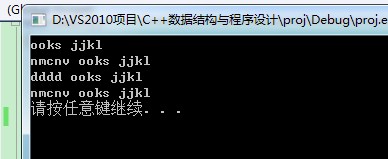----------------------------------List.h------------------------------------
#ifndef LIST_H_XX
#define LIST_H_XX
enum Error_code{rangeerror, underflow, overflow, success};
template<class Node_entry>
struct Node
{
//data member
Node_entry entry;
Node<Node_entry> *next;
Node<Node_entry> *back;
//constructor
Node();
Node(Node_entry entry, Node<Node_entry> *next=NULL, Node<Node_entry>*back=NULL);
};
template<class List_entry>
class List
{
public:
List();
~List();
List<List_entry>& operator = ( List<List_entry> ©);
bool empty() const;
Error_code replace(int position, const List_entry&data);
Error_code retrieve(int position, List_entry&x) const;
Error_code insert(int position, const List_entry&x);
Error_code remove(int position);
int getsize() const;
void print() const;
protected:
//mutable 的作用是在const函数中也可以对其进行修改
int count;
mutable int current_position;
mutable Node<List_entry> *current;
void set_position(int position) const;
};
#include "List.cpp"
#endif------------------------------------------List.cpp-----------------------------------------------
#ifndef LIST_CPP_XX
#define LIST_CPP_XX
#include "List.h"
#include <iostream>
using namespace std;
//结构体构造函数
template <class Node_entry>
Node<Node_entry>::Node()
{
back = next = NULL;
}
template <class Node_entry>
Node<Node_entry>::Node(Node_entry entry, Node<Node_entry> *next/* =NULL */, Node<Node_entry>*back/* =NULL */)
{
this->entry = entry;
this->back = back;
this->next = next;
}
//类实现函数,constructor
template <class List_entry>
List<List_entry>::List()
{
current_position = count = 0;
current = NULL;
}
//destructor
template <class List_entry>
List<List_entry>::~List()
{
while(!empty())
remove(0);
}
//insert a member
//0<=position<=count
template <class List_entry>
Error_code List<List_entry>::insert(int position, const List_entry &x)
{
if(position<0 || position>count)
return rangeerror;
Node<List_entry>*previous, *following, *new_node;
if(position == 0)
{
//如果链表为空
if(count == 0)
{previous = following = NULL;}
else
{
set_position(0);
following = current;
previous = NULL;
}
}
else
{
set_position(position-1);
previous = current;
following = current->next;
}
//完成插入操作
new_node = new Node<List_entry>(x, following, previous);
if(new_node == NULL) return overflow;
if(following!=NULL) following->back = new_node;
if(previous!=NULL) previous->next = new_node;
//指针指向当前操作的位置
current = new_node;
current_position = position;
count++;
return success;
}
//0<=position<coount
template <class List_entry>
Error_code List<List_entry>::remove(int position)
{
Node<List_entry>* previous, *del_node, *following;
if(empty())
return underflow;
if(position<0 || position>count)
return rangeerror;
set_position(position);
if(position == 0)
{
del_node = current;
following = current->next;
if(following!=NULL)following->back = NULL;
delete del_node;
count--;
current = following;
current_position = position;
return success;
}
else
{
del_node = current;
following = current->next;
previous = current->back;
//断开连接
if(previous!=NULL)previous->next = following;
if(following!=NULL)following->back = previous;
//释放内存
delete del_node;
count--;
//如果删除的结点在最后
if(following == NULL)
{
current_position = position-1;
current = previous;
}
else
{
current = following;
current_position = position;
}
}
return success;
}
//current和current_position加了 mutable,所以这两个变量在 const函数里也能修改
template <class List_entry>
void List<List_entry>::set_position(int position) const
{
int i ;
if(position>current_position)
{
for(i=current_position; i<position; i++)
current = current->next;
}
else
{
for(i=position; i<current_position; i++)
current = current->back;
}
current_position = position;
}
//读取指定位置的数据
//0<=position<count
template <class List_entry>
Error_code List<List_entry>::retrieve(int position, List_entry&x) const
{
if(empty())
return underflow;
if(position<0 || position>count)
return rangeerror;
set_position(position);
x = current->entry;
return success;
}
//打印函数,注意不要在该函数中直接操作修改current 或调用 set_position
template <class List_entry>
void List<List_entry>::print() const
{
List_entry x;
int num = getsize();
for(int i=0; i<num; i++)
{
retrieve(i, x);
cout<<x;
}
cout<<endl;
}
//replace 函数
//0<=position<count
template <class List_entry>
Error_code List<List_entry>::replace(int position, const List_entry&data)
{
if(empty())
return underflow;
if(position>count||position<0)
return rangeerror;
set_position(position);
current->entry = data;
return success;
}
template <class List_entry>
int List<List_entry>::getsize() const
{
return count;
}
template <class List_entry>
bool List<List_entry>::empty() const
{
return (count == 0);
}
//如果返回值为void 那么只能实现单重赋值,下面的方法可以实现多重赋值如first_list=second_list=third_list
//另外要注意的是不能简单地赋值current和current_position,因为析构函数中会调用delete所以必须要在此处重新
//分配内存,即调用insert函数
template <class List_entry>
List<List_entry>& List<List_entry>::operator=( List<List_entry> ©)
{
int num = copy.getsize();
List_entry data;
for(int i=0; i<num; i++)
{
copy.retrieve(i, data);
this->insert(i, data);
}
return *this;
}
#endif--------------------------------- 测试代码 -----------------------------------------------
#include <iostream>
#include "List.h"
using namespace std;
int main()
{
List<char*> tt;
tt.insert(0, "mmsa ");
tt.insert(1, "jjkl ");
tt.insert(1, "ooks ");
tt.remove(0);
tt.print();
tt.insert(0, "nmcnv ");
tt.print();
List<char*> dd, mm;
mm = dd = tt;
dd.replace(0, "dddd ");
dd.print();
mm.print();
system("pause");
return 0;
}
------------------------- 测试截图 ---------------------------























 924
924

 被折叠的 条评论
为什么被折叠?
被折叠的 条评论
为什么被折叠?








